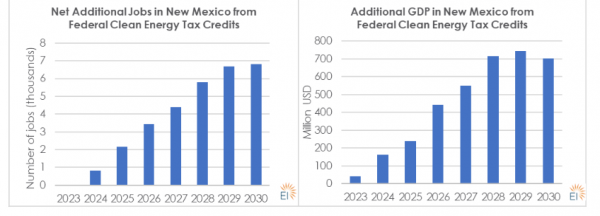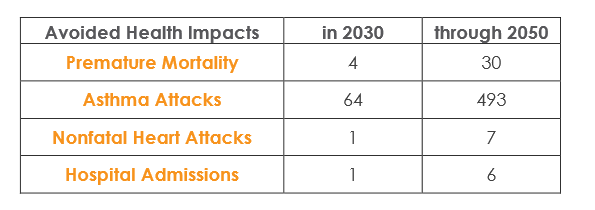(The organization Energy Innovation recently ublished individual state modeling showing the economic and health benefits of Inflation Reduction Act clean energy tax credits for all 48 contiguous states. This modeling focuses on the clean energy investment tax credit, production tax credit, and clean vehicle tax credits because of their outsized impact on jobs and the economy. Below is the analysis for New Mexico).
Federal clean energy tax credits in the Inflation Reduction Act (IRA) are transforming the United States economy, already generating nearly $250 billion in project announcements that could create more than 140,000 new jobs. Prior modeling by Energy Innovation Policy & Technology LLC® showed IRA tax credits are projected to unleash billions in investment by 2030, increasing GDP up to $200 billion and creating up to 1.3 million jobs nationally.
Energy Innovation® used our free and open-source Energy Policy Simulator to study potential state-level benefits on economic growth, jobs, and public health in New Mexico from the IRA. We focus this analysis on clean electricity and clean vehicle tax credits, given the outsized impact of these tax credits on jobs and the economy. This modeling finds these federal clean energy tax credits are projected to lower annual energy costs nearly $79 per household for New Mexico residents in 2030, prevent more than 29 early deaths from pollution through 2050, and cumulatively prevent more than 100 million metric tons of carbon dioxide through 2050 compared to the base case – equivalent to the emissions from 28 coal-fired power plants in one year.
Federal Clean Energy Tax Credits Add to GDP and Cut Household
Energy Spending Federal clean energy tax credits will increase clean energy deployment and electric vehicles sales in New Mexico. These investments and their impacts are projected to increase New Mexico’s GDP by $700 million in 2030. Higher clean energy deployment and decreased spending on gasoline are projected to reduce average annual household energy spending by $79 per year in 2030 and a cumulative $2.3 billion through 2050 across all households in New Mexico. Because more clean energy will be deployed with federal clean energy tax credits, New Mexico is projected to gain more than 6,800 jobs in industries like manufacturing, construction, and sales in 2030. 2 www.energyinnovation.org

Federal Clean Energy Tax Credits Are an Investment in Cleaner, Healthier Communities
IRA programs are expected to shift the U.S. energy system, replacing fuel combustion with clean energy. This transition will dramatically reduce greenhouse gas emissions along with harmful air pollution that causes asthma, respiratory illness, and premature death. Federal clean energy tax credits are projected to prevent 29 premature deaths and 64 asthma attacks in New Mexico through 2050. The shift to clean energy is expected to have a particularly positive impact on the health of communities of color and low-income communities, which are disproportionately affected by vehicle and power plant pollution. Pollution reductions in neighboring states would avoid additional premature deaths and health impacts as well. Avoided Health Impacts in 2030 through 2050 Premature Mortality 4 30 Asthma Attacks 64 493 Nonfatal Heart Attacks 1 7 Hospital Admissions 1 6

Methodology
We identify incremental state clean electricity deployment by comparing two scenarios from modeling by the National Renewable Energy Lab: the Mid-case, nascent techs, current policies scenario and the No IRA, nascent techs, current policies scenario. Comparing these two scenarios reveals the incremental clean electricity deployment from the IRA. We used the incremental clean electricity deployment to develop an IRA policy scenario for each state in the Energy Innovation® Energy Policy Simulator. We estimated clean vehicle tax credit impacts using a a complementary model we developed. We combined the clean vehicle tax credits and clean electricity deployment to create an IRA scenario for New Mexico and compared it against a case without the IRA to find outputs for changes in emissions, health impacts, statewide household savings, GDP, and jobs.
See Energy Innovation’s Analysis for 47 other states



